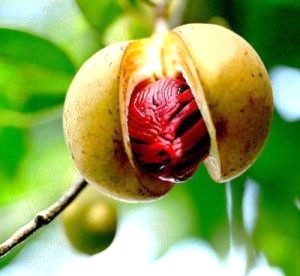Siau Island is known as one of the best nutmeg producers in the world, besides the Banda Islands, Maluku. As far as the eye can see, especially towards the hills and Mount Karangetang, there are nutmeg trees. No wonder, nutmeg has become an icon for the island.
Siau nutmeg does have its own special qualities. Compared to nutmeg from other regions in Indonesia, the quality and characteristics of Siau nutmeg are different. Currently, Siau nutmeg is the only nutmeg commodity in Indonesia that has received a geographical indication certificate (GIS), which is a sign that indicates the area of origin of an item which due to geographical environmental factors gives certain characteristics and quality to the goods produced.
The advantages of nutmeg, which is internationally known as Pala Siau, include its distinctive aroma and oil quality, making it popular with domestic and foreign consumers. Pala Siau has the highest oil content compared to other regions, which is 80-100 percent, while other regions’ nutmeg is 50-70 percent. The essential oil content in Siau nutmeg seeds reaches 2.39 percent, while the essential oil content in its mace reaches 17.27 percent.
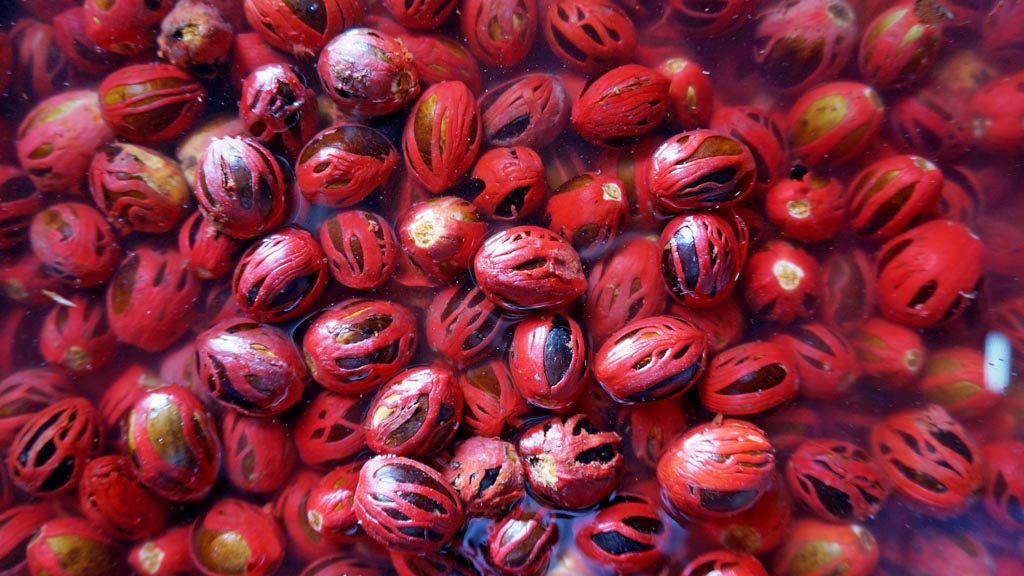
Nutmeg seeds still attached to the red net or mace are being soaked before being separated from the seeds, Friday (2/6), in a warehouse on Siau Island, Siau Tagulandang Biaro (Sitaro) Islands Regency, North Sulawesi.
Another advantage is the aroma and nutmeg seeds that are almost perfectly round without wrinkles. The aroma of Siau nutmeg is due to the high myristicin content compared to nutmeg from other regions. The myristicin content of Siau nutmeg seeds reaches 13.19 percent, while Banda nutmeg is only 11 percent. The essential oil content in the mace is also quite high, reaching 30.39 percent.
The fertility of the land on Siau Island is believed to be related to the superiority of nutmeg. This fertility cannot be separated from the existence of Mount Karangetang which until now is still actively spewing material from the earth’s stomach. The eruption has an impact on the structure of volcanic soil containing phosphorus, calcium, potassium, and magnesium which are very suitable for types of hard plants such as nutmeg. It is not surprising that nutmeg production around Mount Karangetang is very good and becomes an organic nutmeg product.
History
The nutmeg plants that now thrive on Siau Island are the Myristica fragrans Houtt type which has high quality and productivity. Historically, the Siau nutmeg plants are inseparable from the nutmeg that grows in the Banda Islands, Maluku. From a number of literatures, it is stated that the nutmeg plants in the Sitaro Islands Regency, including Siau Island, entered through trade relations with the Ternate Kingdom. The ancestors of the Sitaro people used to sail to Ternate to trade and when they returned they brought nutmeg seeds.
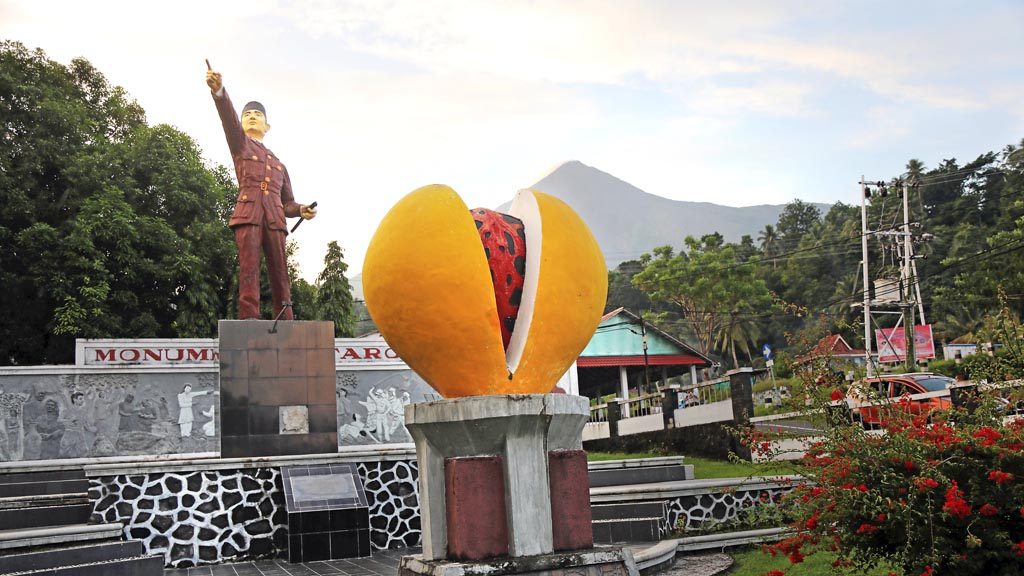
The icons of nutmeg as the main source of livelihood are displayed in the Sitaro Monument, Siau Island, Sitaro Islands Regency, North Sulawesi.
In the book of Geographical Indication Requirements for Siau Nutmeg , it is stated that the Siau Kingdom was founded in 1510 by King Lokongbanua II (1510-1549). At a certain time, this kingdom was subject to and became part of the Ternate Sultanate. This is thought to have influenced the mobility of people from Siau Island to the Maluku region and vice versa. Nutmeg seeds were part of the goods brought home from Ternate and then planted on the island. In its development, nutmeg grown in Siau produced nutmeg fruit of better quality than nutmeg from its place of origin.
It is no wonder that the Siau Kingdom located in North Sulawesi was once fought over by European countries because of its spices. The Portuguese, Spanish, and Dutch once attacked each other to fight over the spice yields of the Siau Kingdom.
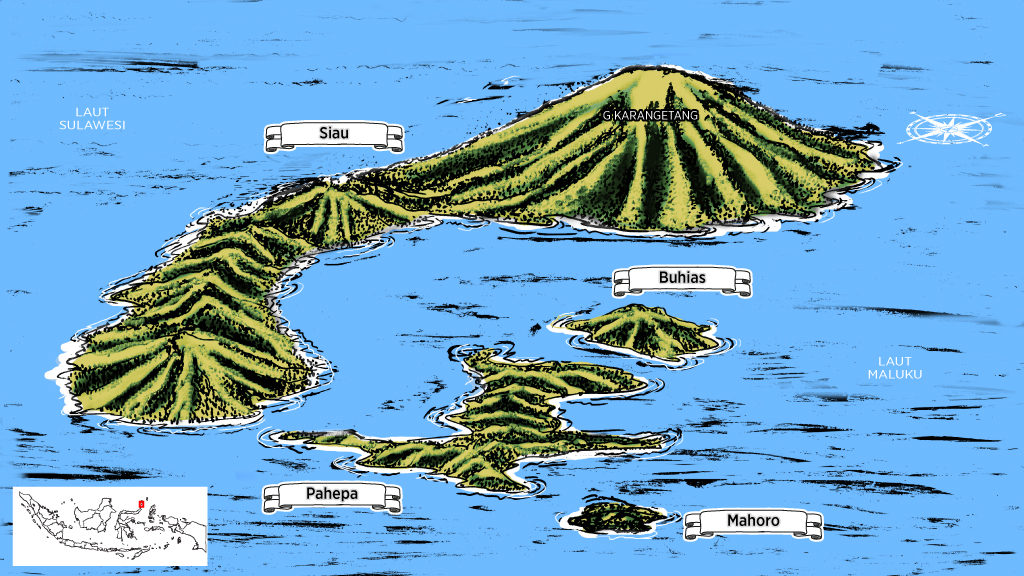
Economic pillar
For the people of Siau, nutmeg is not just a plant, but also a source of pride and social identity. The people of Siau feel incomplete if they do not have a nutmeg plant. Not only that, the nutmeg plant which has been a heritage for hundreds of years is still the backbone of the economy in Siau and the Sitaro Islands Regency. Around 80 percent of the 65,827 residents of the Sitaro Islands Regency depend on nutmeg and coconut commodities for their livelihoods.
Based on data from the Agriculture, Plantation and Forestry Service of Sitaro Islands Regency, plantation crops, especially nutmeg, cloves, and coconuts, are the main commodities of the Sitaro community. Statistical data shows that the contribution of the plantation sector to economic growth in Sitaro Islands Regency is relatively dominant.
Nutmeg plants provide the largest contribution to the formation of gross domestic product (GRDP) figures compared to other sectors. Based on the Regional Statistics of Sitaro Islands Regency 2016, the GRDP figure based on current prices of Sitaro Islands Regency in 2014 showed an amount of IDR 1.375 trillion.
Of the nine development sectors, the agricultural sector with the plantation subsector is the most dominant sector contributing to the GRDP, which is 36.04 percent. This figure is the largest contribution from nutmeg commodities, which significantly contributed to the economic growth of Sitaro Regency in 2014.
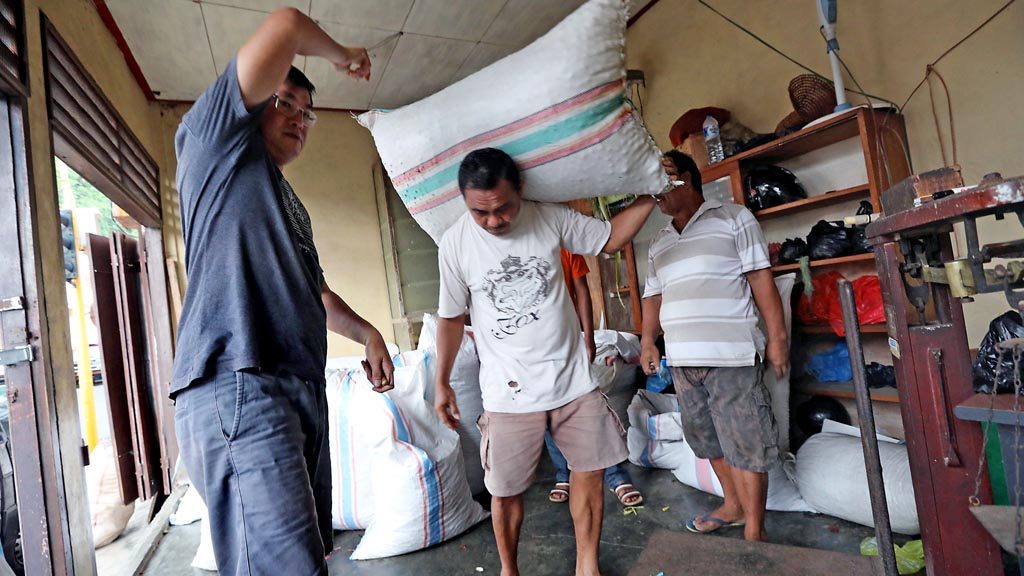
Nutmeg trading activities at the market on Siau Island, Sitaro Islands Regency, North Sulawesi, Friday (2/6). Small traders buy nutmeg and mace from residents’ harvests on a small scale, while large collectors buy more in quintals.
Currently, the nutmeg plantation area on Siau Island is 3,437 hectares, with 2,084 hectares of agricultural area that has been produced. The average productivity is around 2.5 tons of dry nutmeg seeds per hectare per year with a total annual production of 5,210 tons of dry nutmeg seeds with shells.
Based on records from the North Sulawesi Industry and Trade Service, nutmeg exports from the province are 1,000-2,000 tons per month. Nutmeg exports from the province contribute around 75 percent of Indonesia’s total nutmeg exports. The province’s nutmeg is mainly sent to European countries, such as France, the Netherlands, and Italy as well as Vietnam. Most of the nutmeg exported from North Sulawesi comes from Sitaro Regency, the producer of Siau nutmeg.
Constraint
Although it continues to be in demand in the international market, Siau nutmeg and nutmeg from other regions in Indonesia generally face a number of obstacles. One of the obstacles is the sustainability of nutmeg plants, both the threat of stem borer pests, productivity, or rejuvenation of nutmeg plants. Nutmeg plants on Siau Island are generally inherited nutmeg plants that are hundreds of years old, which has an impact on their low productivity.
Not only productivity, the threat of nutmeg plant borer pests is also an obstacle felt by nutmeg farmers in Siau. Out of 100 trees, two to three trees were found to be attacked by the pest. For this reason, the local government needs to encourage the rejuvenation of nutmeg plants in maintaining the sustainability of nutmeg plants in their area.
In addition to the sustainability of nutmeg plants, Siau nutmeg farmers are also affected by notifications from export destination countries, especially in the European Union. The rejection is suspected to be related to excess aflatoxin content above the tolerable threshold. Data from the European Commission’s Food and Feed Safety Alert (RASFF) shows an increase in cases of rejection of nutmeg exports from Indonesia to European Union countries. In 2011 there were seven cases and it dropped in 2012 to three cases. However, in 2013 it increased again to six cases, in 2014 there were 12 cases, in 2015 there were eight cases, and in 2016 there were 24 cases.
To overcome these problems, several agencies have stepped in to improve the quality of Indonesian nutmeg. One of the collaborations is to collaborate with the European Union in an effort to improve the quality of Indonesian nutmeg through the Trade Support Program II in 2015 and Siau nutmeg became a pilot project at the production stage until after the nutmeg harvest. This pilot project identified and implemented practical improvements in the quality of nutmeg through the stages of production, transportation, storage, and shipping so that Indonesian nutmeg meets the required international standards.
Efforts to improve the quality of Siau nutmeg are expected to not only improve nutmeg on plantations, but also post-harvest handling so that Siau nutmeg products are expected to restore the glory of Indonesian nutmeg in the world market.
(ANTONIUS PURWANTO/KOMPAS RESEARCH AND DEVELOPMENT)
source: https://jelajah.kompas.id/jalur-rempah/baca/pala-siau-primadona-ekspor-rempah-dunia/

